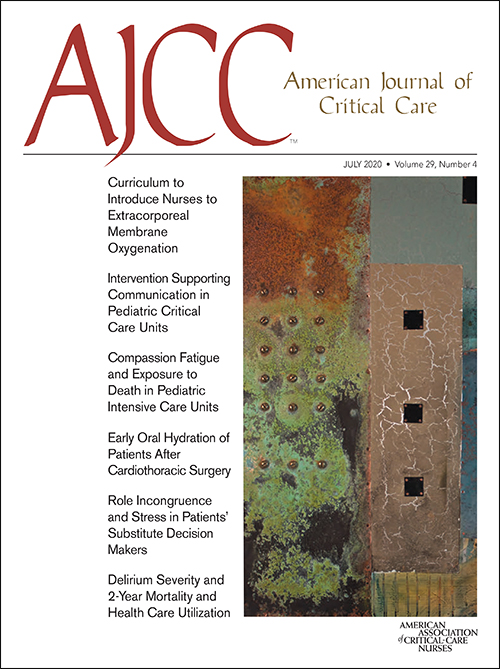The H1N1 influenza pandemic in 2009 was an impetus for more intensive care units (ICUs) to adopt ECMO for patients with acute respiratory distress syndrome (ARDS), and now, it is being used as a life-sustaining treatment for patients with the most severe complications of COVID-19. Despite the growing use of ECMO, few standardized training pathways are available for critical care nurses.
Vanderbilt University Medical Center, in Nashville, Tennessee, designed and rapidly deployed a curriculum specifically to equip nurses new to ECMO with the knowledge, skills and confidence necessary to provide proficient and safe care for patients receiving ECMO. The training coincided with the pre-COVID integration of ECMO into the medical ICU and an ICU-wide transition to a team-oriented approach to care for patients receiving ECMO. The new ECMO bedside care delivery model shared responsibilities among the primary ICU team supported by an ECMO team, including on-call perfusionists who have advanced training to control the ECMO machine.
“Curriculum to Introduce Critical Care Nurses to Extracorporeal Membrane Oxygenation” describes the multifaceted program, which incorporated a basic safety course, an advanced user course and electronic learning modules. The study is published in the July issue of American Journal of Critical Care (AJCC).
Co-author Whitney Gannon, MS, MSN, is director of Vanderbilt’s ECMO quality and education. The multiprofessional project team included nurses, nurse educators, perfusionists and physicians.
“To our knowledge, this is the first study to design, implement and evaluate an adult ECMO curriculum for a high volume of critical care nurses without significant ECMO experience,” she said. “Our ECMO training is an effective, resource-efficient and pragmatic solution that can be used across different types of ICUs and across institutions.”
Over a six-month period from October 2018 through March 2019, 426 nurses participated in the training. Excluding those with prior ECMO experience, a total of 301 critical care nurses new to ECMO participated in the basic safety course, with 107 of them also taking the advanced user course. Class sizes for each session were intentionally limited to maximize attention, participation and comprehension.
The basic safety course included one hour of didactic material followed by an hour of low-fidelity simulation, for a maximum of six nurses per class. It served as the minimum requirement for ICU nurses to directly care for a patient receiving ECMO and was a prerequisite for the advanced user course.
Building on the basic course material, the advanced user course offered a platform for higher level nursing education and empowered learners to become resources for clinicians in the ICU setting. The one-hour didactic session was followed by a one-hour simulation that included a mock cannulation.
Three online modules reinforced the concepts delivered through the didactic and simulation content.
In addition, 38 nurses cared for ECMO patients after participating in the curriculum during the study period. Their evaluations gave high ratings for the curriculum (median of 4.0 on a 5.0 scale for all questions) and provided additional feedback for the instructional developers.
Overall, the curriculum was well reviewed by participants, and evaluations showed increased understanding and knowledge, as well as higher confidence levels. For both courses, postcourse exam scores were higher than precourse scores for the whole cohort and when stratified by ICU type.
The study is part of AACN’s growing library of clinical resources related to caring for critically ill patients with COVID-19, including a free self-paced course, “COVID-19 Pulmonary, ARDS and Ventilator Resources.” The COVID-19 resources also include free pocket cards, webinars, procedure manual excerpts and journal articles.
To access the article and full-text PDF, visit the AJCC website at www.ajcconline.org.
About the American Journal of Critical Care: The American Journal of Critical Care (AJCC), a bimonthly scientific journal published by the American Association of Critical-Care Nurses, provides leading-edge clinical research that focuses on evidence-based-practice applications. Established in 1992, the award-winning journal includes clinical and research studies, case reports, editorials and commentaries. AJCC enjoys a circulation of more than 120,000 acute and critical care nurses and can be accessed at www.ajcconline.org.
About the American Association of Critical-Care Nurses: For more than 50 years, the American Association of Critical-Care Nurses (AACN) has been dedicated to acute and critical care nursing excellence. The organization’s vision is to create a healthcare system driven by the needs of patients and their families in which acute and critical care nurses make their optimal contribution. AACN is the world’s largest specialty nursing organization, with more than 125,000 members and over 200 chapters in the United States.
American Association of Critical-Care Nurses, 27071 Aliso Creek Road, Aliso Viejo, CA 92656; 949-362-2000; www.aacn.org; facebook.com/aacnface; twitter.com/aacnme
Original post https://alertarticles.info




